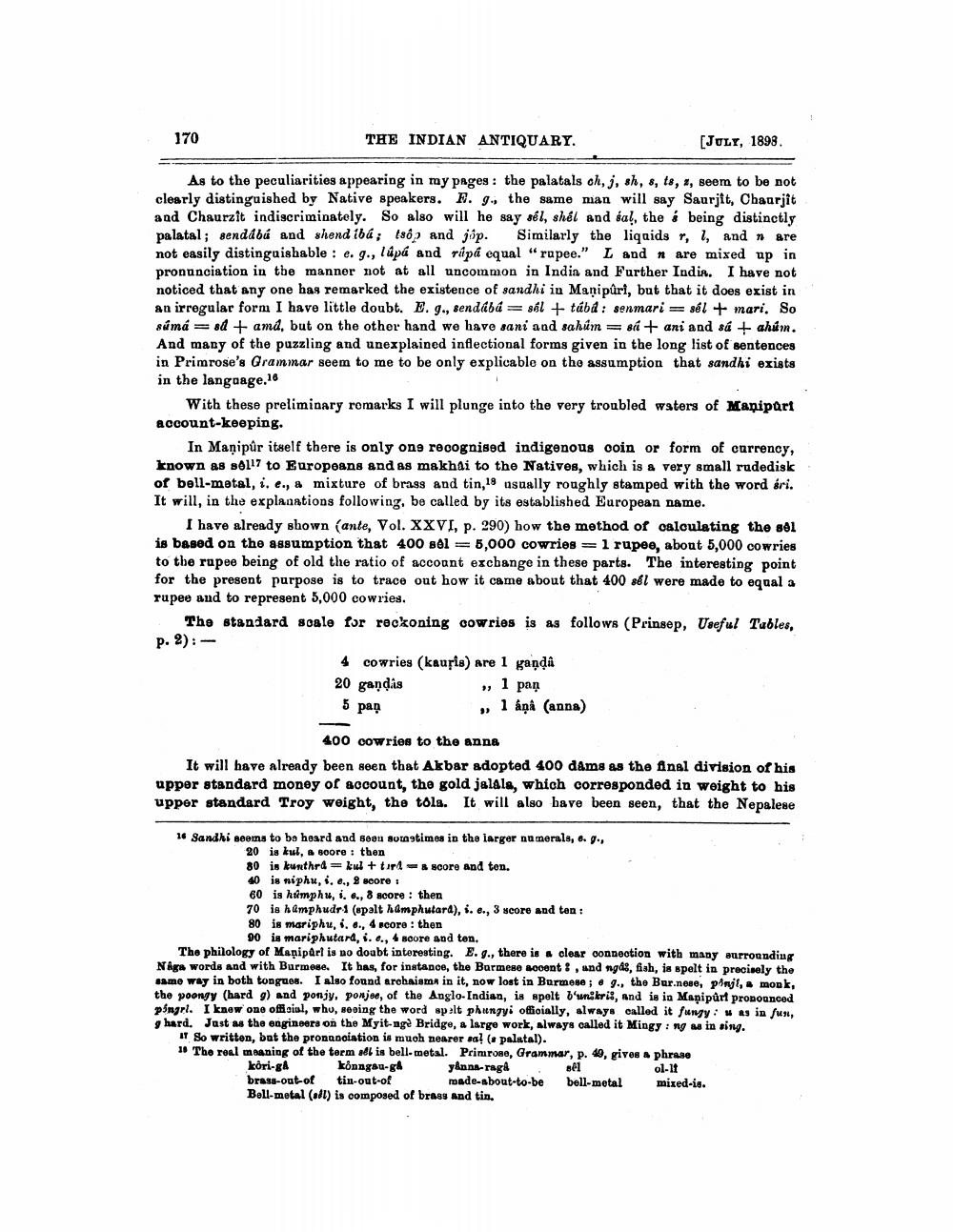________________
170
THE INDIAN ANTIQUARY.
[JULY, 1893.
As to the peculiarities appearing in my pages: the palatals ch, j, sh, 8, ts, *, seem to be not clearly distinguished by Native speakers. E. g., the same man will say Saurjit, Chaurjit and Chaurzit indiscriminately. So also will he say sél, shél and sal, the á being distinctly palatal; senddbá and shend 16á; 1869 and jóp. Similarly the liquids rl, and are not easily distinguishable : e. g., lúpá and ripá equal "rupee." Land * are mixed up in pronunciation in the manner not at all uncommon in India and Further Indin. I have not noticed that any one has remarked the existence of sandhi in Manipûri, but that it does exist in an irregular form I have little doubt. E. g., sendíbú= sál + tábd: senmari = sél + mari. So sámá = 8+ amd, but on the other hand we have sani and sahům = si + ani and sá + ahúm. And many of the puzzling and unexplained inflectional forms given in the long list of sentences in Primrose's Grammar seem to me to be only explicable on the assumption that sandhi exists in the language.16
With these preliminary romarks I will plunge into the very troubled waters of Manipart account-keeping.
In Manipur itself there is only one recognised indigenous coin or form of currency, known as soll7 to Europeans and as makhai to the Natives, which is a very small rudedisk of bell-metal, i. e., a mixture of brass and tin, 19 usually roughly stamped with the word éri. It will, in the explanations following, be called by its established European name.
I have already shown (ante, Vol. XXVI, p. 290) how the method of caloulating the sol is based on the assumption that 400 sel = 5,000 cowries = 1 rupee, about 5,000 cowries to the rupee being of old the ratio of account exchange in these parts. The interesting point for the present purpose is to trace out how it came about that 400 sél were made to equal a rupee and to represent 5,000 cowries.
The standard soale for reckoning cowries is as follows (Prinsep, Useful Tables, p. 2): -
4 cowries (kausis) are 1 ganda 20 gandas
1 pan 1 åņa (anna)
5 pan
400 cowries to the anna It will have already been seen that Akbar adopted 400 dams as the final division of his upper standard money of account, the gold jalals, which corresponded in weight to his upper standard Troy weight, the tola. It will also bave been seen, that the Nepalese
16 Sandhi seems to be heard and Beau sotagtimes in the larger numerals, 6. 9.,
20 is kul, & soore : then 80 is kurthri = kul + tire & score and ton. 40 is niphu, . e., 8 score : 60 is hamphu,, 6., 8 score : then 70 is hamphudr 1 (spalt hamphutard), s. e., 3 score and ten : 80 is mariphu, ..., 4 score : then
90 is mariphutard, i. e., 4 score and ten. The philology of Manipdrl is no doubt intoresting. E. g., there is a clear connection with many surrounding Nr words and with Burmese. It has, for instance, the Burmese accent : , and ngás, fish, is spelt in precisely the same way in both tongues. I also found arobaismo in it, now lost in Burmese;. 9., the Bur.nese, pwl, monk, the poongy (hard g) and ponjy, ponjee, of the Anglo-Indian, is spelt bunkris, and is in Manipurt pronounced pingrl. I knew one official, whu, seeing the word spolt phongyi officially, always called it fungy: as in fun, g hard. Just as the engineers on the Myit-nge Bridge, a large work, always called it Mingy : ng as in sing.
IT So writton, but the pronanciation is much nearer sal (o palatal). 1. The real meaning of the term all is bell-metal. Primrose, Grammar, p. 49, gives a phrase kôri-g
konngau- g y nna-raga
sel
ol-1 brass-out-of tin-out-of made-about-to-be bell-metal mixed-is. Bell-metal (oll) is composed of brass and tin.




